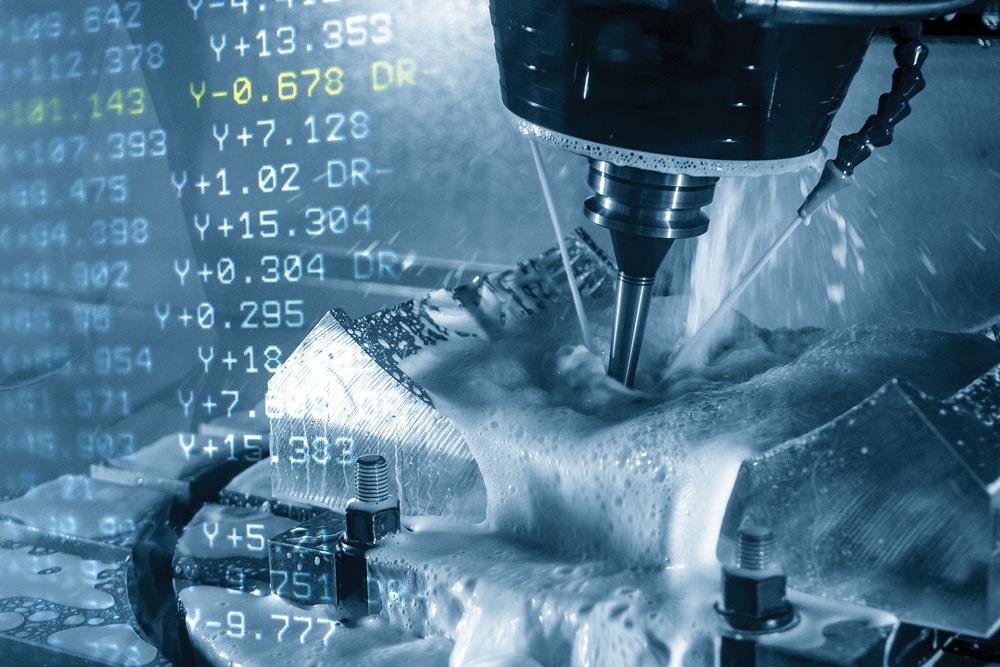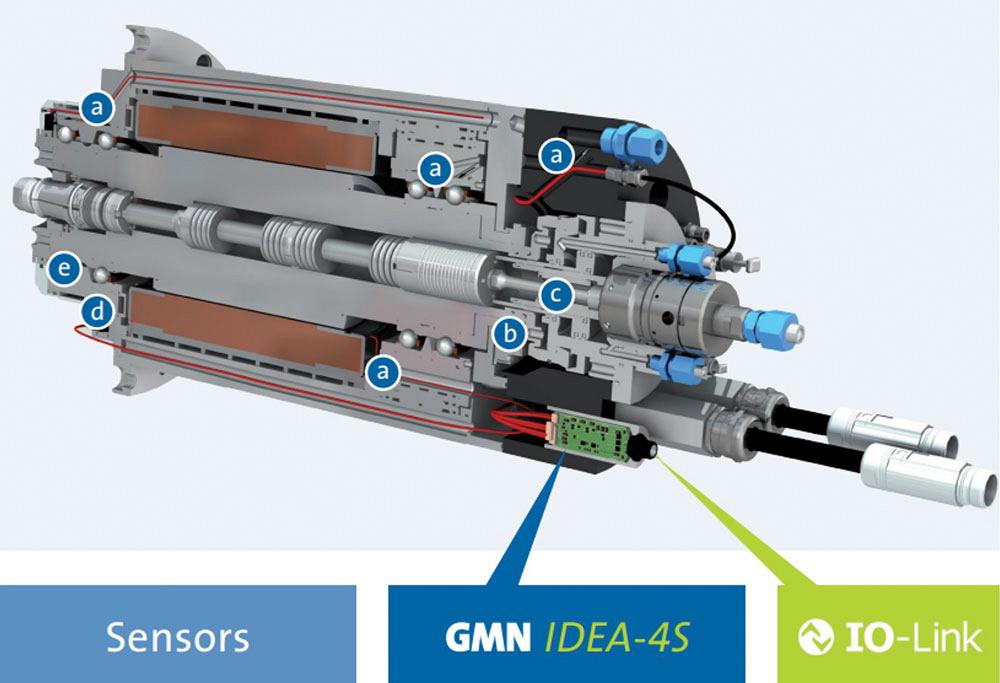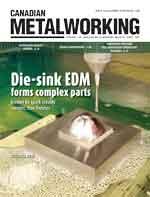Associate Editor
- FMA
- The Fabricator
- FABTECH
- Canadian Metalworking
Spindle maintenance update
A look at how sensor technology is reducing spindle downtime
- By Lindsay Luminoso
- October 14, 2020
- Article
- Metalworking

Industry 4.0 technology and the latest sensors allow an operator to watch all the data points and make smart, informed decisions without needing a third party to determine if the spindle requires maintenance.
Known as the heart of the machine, the spindle is designed to allow a machine tool to function. Yet it is sometimes overlooked when it comes to overall machine maintenance. With spindles being buried in the machine tool, the old adage "out of sight, out of mind" rings true. But when spindle failure occurs, the machine can no longer run.
Long and costly machine downtime is something all shops hope to avoid. This is why spindle maintenance is essential. And with today’s technology moving toward Industry 4.0 and digital monitoring, preventive maintenance is all the easier.
Canadian Metalworking spoke with Don Loveless, sales manager, GMN USA, Bristol, Conn., about spindle maintenance and monitoring technologies. Here’s what he had to say.
CM: How has preventive maintenance programs for spindles changed over the years?
Loveless: I can remember back when preventive maintenance programs were dictated by when the machine and particularly the spindle actually stopped working. When the spindle stopped running, a shop would have to send it out for repair and, in most cases, the machine would sit idle until the spindle came back. Depending on the issue, this could mean significant downtime.
Preventing downtime is one of the biggest challenges for machine shops. Time is money, and over the years shops are realizing that they cannot afford any downtime, let alone long periods where the machine is not running.
In the past one of the preventive maintenance options was the spare spindle method. Depending on the number of machines and types of spindles, this option can be very expensive.
Another big change to preventive maintenance over the years relates to spindle monitoring. New technology is coming out every day to monitor all aspects of spindle life, but it has been particularly focused on monitoring bearing temperature and shaft growth. The more features or aspects monitored, the more complex the technology became. At one point the back end of the machine started to look like spaghetti, with wires coming out everywhere and connecting to different terminals. This just wasn’t an effective way of doing it.
CM: Where are you seeing Industry 4.0 technology in spindle maintenance?
Loveless: The technology available today allows operators to monitor spindle maintenance in real time. Sensors are available to monitor all aspects of the spindle, allowing machine operators to see trends over time. If the machine is starting to trend downward, the operator knows about it immediately. Sensors also collect data on what part of the spindle is causing the downward trend, whether it’s a bearing or something else that caused it. This is something fairly new.
GMN Germany recently introduced a system that monitors bearing and motor temperatures, speed and rotation angle, tool clamping, vibration, and shaft axial displacement. Today spindle monitoring has been streamlined so that there is really only one wire collecting all the data points and feeds it into the machine control. It’s become so much easier.
Before this technology was available, operators had to perform manual checks or tests to see how the spindle was running. A shop could purchase an inexpensive unit to collect vibration data. The shop would collect a specific amount of data, based on a specific interval time or date, and then send that data directly to a rebuild centre. That service company then evaluated the data to determine if the spindle needed repairs.

Sensors are available to monitor all aspects of the spindle, allowing machine operators to see trends over time. Image courtesy of GMN USA.
If the rebuild centre said the spindle needed to be sent in for repairs or maintenance, the shop would need to send it in, leaving the machine idle until the spindle was sent back.
Industry 4.0 technology and the latest sensors allow an operator to watch all the data points and make smart, informed decisions without needing a third party to determine if the spindle requires maintenance. The data helps shops determine the baseline of the machine, and that baseline can be used to check for downward trends.
This makes it much easier for preventive maintenance because a shop can plan earlier for spindle issues and purchase spare parts like bearings ahead of time. It can also help to co-ordinate production schedules, maybe using other machines or shifting around jobs if the shop anticipates a machine being unavailable because of a spindle repair or maintenance issue. This technology really allows shops to react faster and smarter.
CM: How can shops take advantage of the latest sensor tech, and what do they need to consider before jumping in?
Loveless: Shops really need to decide if adding a special spindle is right for them. It may not be the most important need for a shop currently, but it is certainly becoming more and more of a priority. The investment in a spindle with the latest monitoring technology is an investment and takes some planning. A shop can’t just take an existing spindle and retrofit it with the latest technology and hope for the best. Incorporating a special spindle requires shops to look at the machine infrastructure to ensure that there is enough room for all components to fit and there is enough room in the machine and control for it.
A lot of customization is involved too. We need to know exactly what the shop wants and is looking to monitor because there are so many different features that can be offered through the system. A shop may not want all options, so it needs to know what exactly it requires. It’s also important to plan ahead and anticipate what options could be beneficial for the future.
One of the primary options we see shops asking for is a temperature sensor for the bearings. This enables the bearings and motor temperature to be monitored, which will then allow a shop to use the data to determine potential shaft growth. Based on this information, the operator can adjust spindle parameters to compensate for that growth. This is important because with thermal expansion of the shaft, the machine will cut deeper than needed. Accounting for a specific amount of shaft growth allows an operator to compensate by backing the tool off just the right amount to maintain the specified size.
The latest technology can monitor everything from temperature to tool clamping, as well as axial displacement, where a shop can see if the shaft is being pushed back by the cutting force. It can cover almost any part of the spindle.
CM: Where do you see preventive maintenance for spindles going in the future?
Loveless: The latest spindle technology and sensors are going to be increasingly demanded by shops. And soon it’s going to be commonplace in most shops. I think everyone’s heading that way, particularly in an environment where skilled labour is so hard to find. No shop wants to have an operator spend his or her time monitoring the machine spindle and various features constantly. It’s a waste of time. Instead, a shop can use this technology to have the spindle inform the operator when it’s developing a problem. This way, an operator is not tied to monitoring a number of machines. Alarms can be used to inform a shop when there is a problem.
It’s also going to allow them to kind of forecast a little bit better. A shop can get an idea of how many hours each spindle has been running and can trend based on that information. For instance, if the spindle is good for 6,000 hours, then when it nears this operational time, it can be monitored more closely for normal wear and tear. If a shop is running the same parts on a machine day after day, which most machine shops do, they can use the data to better plan what is needed and when.
I think it’s going to be demanded on all machine tools moving forward. Once one shop has it, everyone’s going to want it.
GMN USA, gmnusa.com
About the Author

Lindsay Luminoso
1154 Warden Avenue
Toronto, M1R 0A1 Canada
Lindsay Luminoso, associate editor, contributes to both Canadian Metalworking and Canadian Fabricating & Welding. She worked as an associate editor/web editor, at Canadian Metalworking from 2014-2016 and was most recently an associate editor at Design Engineering.
Luminoso has a bachelor of arts from Carleton University, a bachelor of education from Ottawa University, and a graduate certificate in book, magazine, and digital publishing from Centennial College.
subscribe now


Keep up to date with the latest news, events, and technology for all things metal from our pair of monthly magazines written specifically for Canadian manufacturers!
Start Your Free Subscription- Industry Events
MME Saskatoon
- May 28, 2024
- Saskatoon, SK Canada
CME's Health & Safety Symposium for Manufacturers
- May 29, 2024
- Mississauga, ON Canada
DiPaolo Machine Tools Open House 2024
- June 4 - 5, 2024
- Mississauga, ON Canada
FABTECH Canada
- June 11 - 13, 2024
- Toronto, ON Canada
Zoller Open House & Technology Days 2024
- June 12 - 13, 2024
- Ann Arbor, MI




















